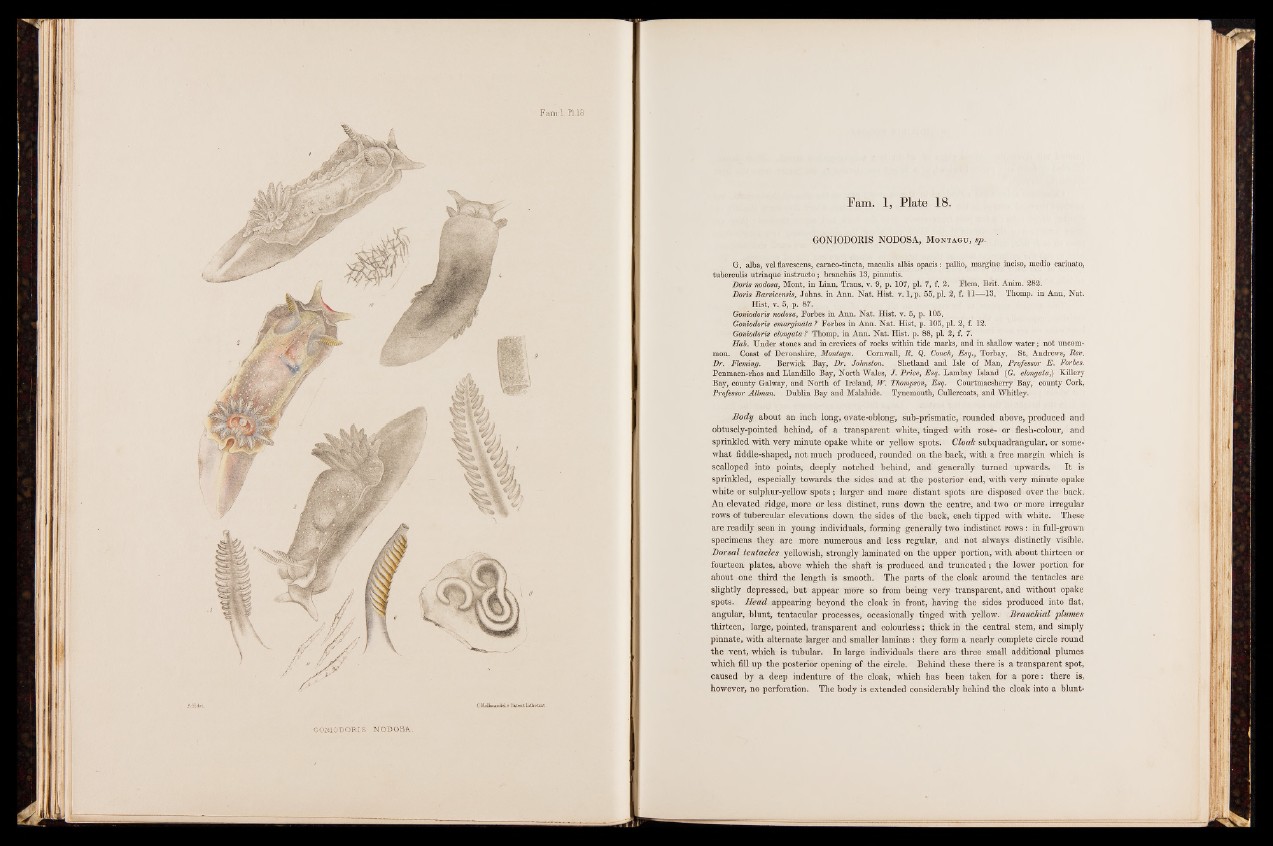
Fam-.l. H.13
OOSiODORIS NODOSA.
Fam. 1, Plate 18.
GONIODORIS NODOSA, Montagu, sp.
G. alba, vel flavescens, cameo-tincta, maculis albis opacis: pallio, margine inciso, medio carinato,
tuberculis utrinque instructo; brancbiis 13, pinnatis.
Doris nodosa, Mont, in Linn. Trans, v. 9, p. 107, pi. 7, f. 2. Elem. Brit. Anim. 282.
Doris Barvicensis, Johns, in Ann. Nat. Hist. v. 1, p. 55, pi. 2, f. 11—13. Thomp. in Ann. Nat.
Hist. y. 5, p. 87.
Goniodoris nodosa, Forbes in Ann. Nat. Hist. v. 5, p. 105.
Goniodoris emarginata ? Forbes in Ann. Nat. Hist. p. 105, pi. 2, f. 12.
Goniodoris elongata? Thomp. in Ann. Nat. Hist. p. 88, pi. 2, f. 7.
Hab. Under stones and in crevices of rocks within tide marks, and in shallow water; not uncommon.
Coast of Devonshire, Montagu. Cornwall, R. Q. Couch, Esq., Torbay. St. Andrews, Rev.
Dr. Fleming. Berwick Bay, Dr. Johnston. Shetland and Isle of Man, Professor E. Forbes.
Penmaen-rhos and Llandillo Bay, North Wales, J. Price, Esq. Lambay Island (G. elongata,) Killery
Bay, county Galway, and North of Ireland, W. Thompson, Esq. Courtmacsherry Bay, county Cork,
Professor Allman. Dublin Bay and Malahide. Tynemouth, Cullercoats, and Whitley.
Body about an inch long, ovate-oblong, sub-prismatic, rounded above, produced and
obtusely-pointed behind, of a transparent white, tinged with rose- or flesh-colour, and
sprinkled with very minute opake white or yellow spots. Cloak subquadrangular, or somewhat
fiddle-shaped, not much produced, rounded on the back, with a free margin which is
scalloped into points, deeply notched behind, and generally turned upwards. It is
sprinkled, especially towards the sides and at the posterior end, with very minute opake
white or sulphur-yellow spots; larger and more distant spots are disposed over the back.
An elevated ridge, more or less distinct, runs down the centre, and two or more irregular
rows of tubercular elevations down the sides of the back, each tipped with white. These
are readily seen in young individuals, forming generally two indistinct rows: in full-grown
specimens they are more numerous and less regular, and not always distinctly visible.
Dorsal tentacles yellowish, strongly laminated on the upper portion, with about thirteen or
fourteen plates, above which the shaft is produced and truncated; the lower portion for
about one third the length is smooth. The parts of the cloak around the tentacles are
slightly depressed, but appear more so from being very transparent, and without opake
spots. Head appearing beyond the cloak in front, having the sides produced into flat,
angular, blunt, tentacular processes, occasionally tinged with yellow. Branchial plumes
thirteen, large, pointed, transparent and colourless; thick in the central stem, and simply
pinnate, with alternate larger and smaller laminae : they form a nearly complete circle round
the vent, which is tubular. In large individuals there are three small additional plumes
which fill up the posterior opening of the circle. Behind these there is a transparent spot,
caused by a deep indenture of the cloak, which has been taken for a pore: there is,
however, no perforation. The body is extended considerably behind the cloak into a blunt-»